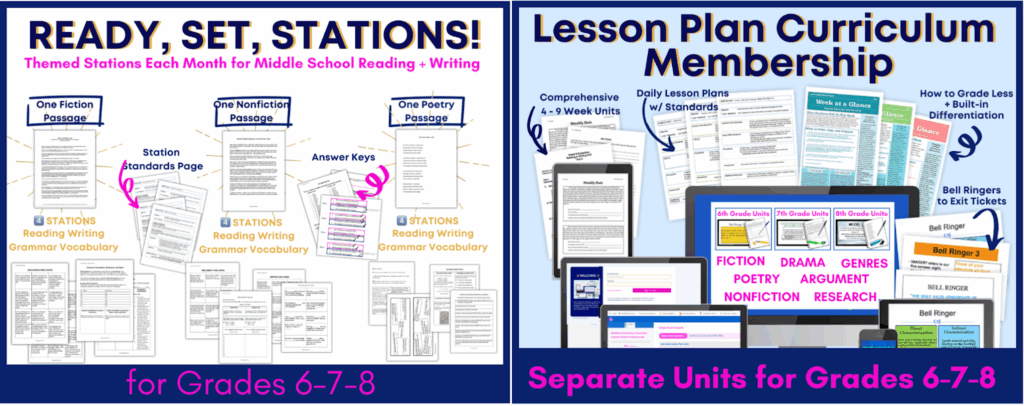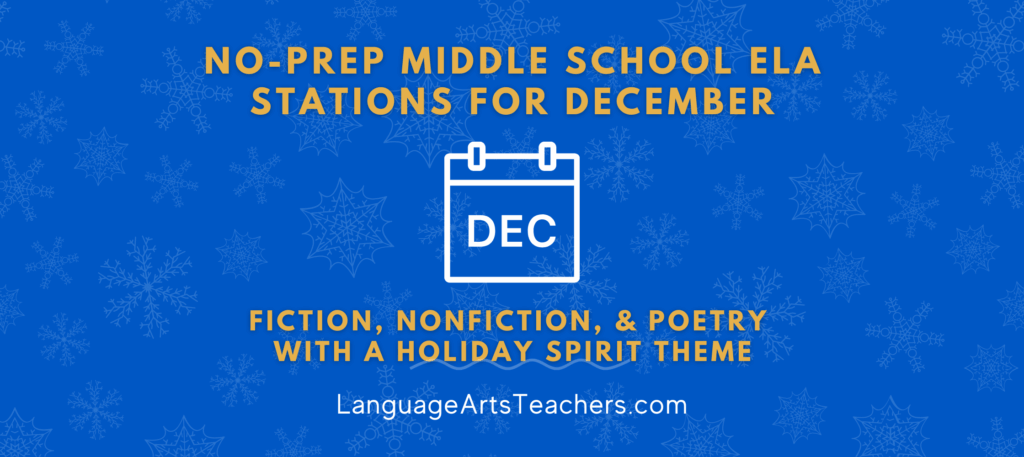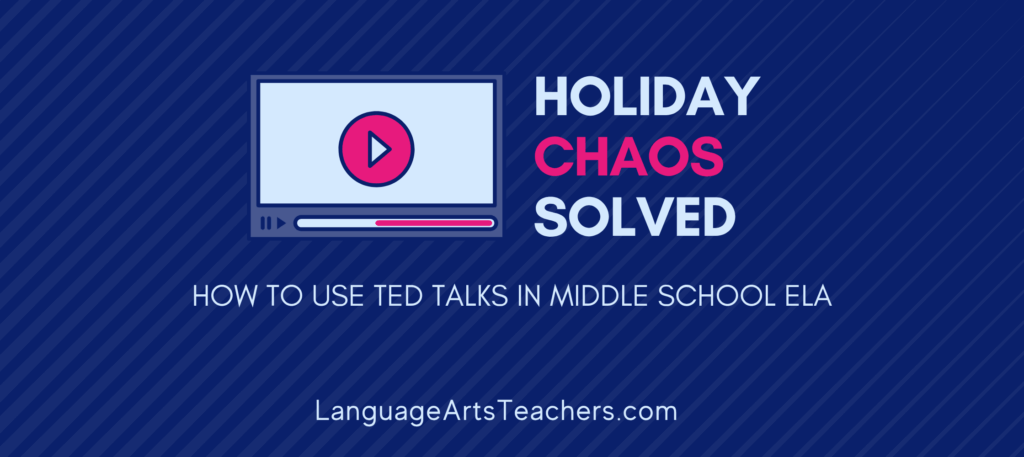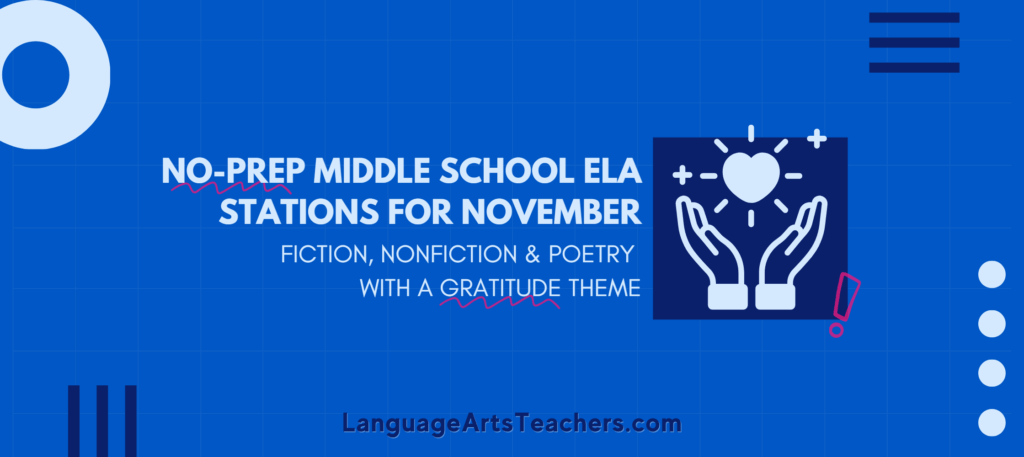Middle School ELA isn’t exactly known for being the place where students beg to do grammar each day.
And I get it! I mean… me, neither! (Or… me, either?).
The secret trick that works for me (what I’ve shared time and time again during the lesson plan membership Q+A Zoom sessions I host each month) is that engaging students in learning and practicing grammar successfully really comes down to keeping things fresh, relevant, and no-prep.
Now that sounds nice I’m sure, but it’s vague and meaningless without specifics that you can go and do right away.
So here’s my step-by-step, actionable list of no-prep or low-prep ideas for teaching grammar:
In just 30 – 40 minutes:
- 1–2 min | Intro: “Today’s power move is ______.” (one skill)
- 6–8 min | Mini-lesson: Quick explanation + 2 examples + 1 non-example.
- 12–18 min | Write/Revise: Students apply the skill in their own writing (If they’re currently working on an essay or other writing project, then apply it to that. If this is simply a “I have to address this writing issue because they’re doing it / not doing it in literally everything” then they can apply & practice it using any piece of writing from the year—formal or informal–even just a casual “reader’s response” or warm-up or free-write will do).
- 6–8 min | Conferring: You circulate with one tiny checklist (for that one skill only).
- 2–3 min | Share/Exit: 1–2 students read a sentence; class shows thumbs for the skill.
Pro Tip: teach one thing per day and grade one thing per piece. No more “everything but the kitchen sink” type grading.
1) 60 second warm-ups / bell ringers
- Because–But–So
- On the board: “Charlie changes ____.”
- Students complete the sentence 3 ways: because…, but…, so…
- Goal: comma usage, clause variety, idea development.
- On the board: “Charlie changes ____.”
- Start/Finish with AAAWWUBBIS
- Write a subordinating conjunction (After, Although, As, When, While, Until, Because, Before, If, Since).
- Students write one opener sentence (comma!) and one finisher (no comma).
- Two lines = a whole lesson in disguise.
- Write a subordinating conjunction (After, Although, As, When, While, Until, Because, Before, If, Since).
- Combine & Shine
- Put 3 choppy sentences from a previous draft on the board (anonymous, from a different class—each class sees a different class’s example).
- Challenge: combine into 1 strong sentence. Share 2 student versions (help students see there’s more than one or even two possible ways to correct).
- Put 3 choppy sentences from a previous draft on the board (anonymous, from a different class—each class sees a different class’s example).
- Mentor Swipe
- Grab a sentence from the class text/novel/article.
- Ask: What’s working? What could we steal? (Name the method: comma with FANBOYS, vivid verb, prepositional opener, etc.)
- Grab a sentence from the class text/novel/article.
- Scramble & Sort
- Write a strong sentence.
- Under it, write the same sentence but broken into chunks.
- Students reorder, then name the punctuation that makes it work.
- Write a strong sentence.
2) Mini-lesson ideas you can repeat all year long (5–7 minutes)
Use this procedure every time:
- Name the move: “Writers use FANBOYS (for, and, nor, but, or, yet, so) to create compound sentences.”
- Show it twice: Two correct examples from a mentor text or your draft.
- Break it once: One incorrect/non-example. Ask: What’s wrong? How fix?
- Give the method: “Independent clause, , FANBOYS + independent clause.”
- State the challenge: “Add one compound sentence to your draft right now.”
Make a list of 8 – 10 “issues” based on what you know needs to be constantly practiced and reiterated throughout the year… And then just rotate through the topics. Common ones to get you started (but modify, omit, switch out as needed):
- Complete vs. fragment
- Subject + predicate (run-ons vs. fused)
- Compound sentences (FANBOYS + comma)
- Complex sentences (AAAWWUBBIS + comma when opener)
- Series & Oxford comma
- Dialogue commas & punctuation
- Precise pronouns (clear antecedents)
- Commonly confused words (its/it’s; there/their/they’re)
3) Everyday places to “catch” grammar IRL
- Read-aloud stops: Pause at a comma/semicolon. Ask, “Why is that mark here?” → Or use / reuse for tomorrow’s mini-lesson
- Slide deck quotes: One line from a previous or future text = today’s mentor / example sentence to imitate for form and function
- Student gold: Start class with a “Sentence of the Day” from a student (anonymous, if needed). Notice → name → imitate.
4) Creativity with Grammar + Punctuation (Perfect for those Oops, I didn’t really plan for today’s mini-lesson days)
- Grammar Scavenger Hunt: In today’s excerpt, find: 1 compound, 1 complex, 1 fragment, 1 series. Label and discuss.
- Syntax Speed-Dating: Post 5 sentence starters around the room (especially if you can grab them from a novel/article/story that students are about to read—not something they’ve already read); partners rotate and finish each in 60 seconds. Discuss the punctuation (what was used, why, impact on meaning, tone, etc.)
- Micro-Dictation: Read one complex sentence aloud twice; students write it. Compare & discuss punctuation choices—more than one way to do this correctly vs. common incorrect choices; how punctuation impacts meaning, etc.
Wrapping it up: What to stop doing
- Grading every error. Pick the one skill you taught.
- Teaching parts of speech in isolation for weeks. Teach them when they matter to a sentence you’re actually writing.
- Endless worksheets. If it doesn’t touch their draft, it doesn’t stick.
Quick reference anchor charts (write once; reuse all year)
- FANBOYS = for/and/nor/but/or/yet/so → comma + FANBOYS between two complete thoughts.
- AAAWWUBBIS openers need a comma (After, Although, As, When, While, Until, Because, Before, If, Since)
- Series = 3+ items → commas between, optional Oxford before “and.”
- Run-on test: Can it be two sentences? If yes, fix with . ; , FANBOYS, or AAAWWUBBIS.
Steal Grammar from Everywhere
Song lyrics, memes, text messages, sports headlines. If it has words, it has grammar to discuss. Students engage more with material from their world than textbook sentences about nothing.
Remember: You don’t need to love grammar to teach it well. You just need to help students see how it makes their writing stronger. Start small, be consistent, and use what they’re already writing. The fancy terminology can wait until they understand how language actually works.
Grammar, punctuation, and mechanics practice is embedded inside both the ready-made ELA Lesson Plan Units AND the Ready, Set, Stations™ materials for consistent, non-random learning experiences that spiral alongside everything else you’re teaching. Take your pick!




